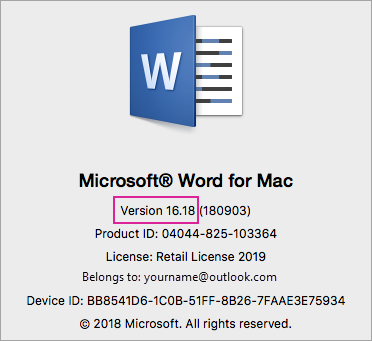Some background:
- Volume License Serializer For Office 2016 For Mac Os
- Volume License Serializer For Office 2016 For Mac
- Volume License Serializer For Office 2016 For Mac Free
- Volume License Serializer For Office 2016 For Mac Download
In order to activate office we were able to use a serializer.pkg from microsoft to license / activate Office for Mac 2016 and this.pkg has worked up until 16.16. Today, I noticed that updating to 16.17 via our normal method prompts the user to activate MS Office again and our serializer.pkg isn't working. In the folder create a folder titled volumelicense. Place the MicrosoftOffice2016VLSerializer.pkg file in the volumelicense folder. Open Terminal and change to the folder you created in step 1. Run the Office2016PkgBuilder.sh script. The script will download the required files and create a folder called result.
In my organisation I deploy software with Munki, previously with Office 2011, it was pretty easy to deploy and get a fully up to date install of Office 2011
- Install the full volume licence installer from the VLSC site which was version 14.3.0 and around 1Gb
- Let Munki apply the latest combo updater it has (14.5.8) and around 120Mb
And we’re done. Pretty easy and painless and about 1.1Gb of data to send to the client.
However, in Office 2016, Microsoft has sandboxed their applications, which is the right thing do™. However what this means is that any shared content the apps use such as frameworks, fonts, and proofing tools all need to be contained within each application bundle. Previously in Office 2011, the apps could get this content from a shared location such as /Library/Application Support
This means that our Office 2016 installer package is only about 1.3Gb, the installer then just copies the same files into each app bundle at install time via a postinstall script. That results in each app being rather large as you can see here.
It also means that the Office 2016 updates that Microsoft offer for each app are huge, approx 800Mb per app.


So now if we applied our same methodology of deploying Office 2011 to Office 2016 we would end up with something like this:
- Install the full Office 2016 VL installer (1.3GB)
- Let Munki apply each app update ~800Mb times 5 apps (Word, Excel, PowerPoint, OneNote, Outlook)
That means we are pushing about 5gb to the client just to install office. Thats insane.
Solution?
Well we only need the full VL installer for its special licensing package that generates the volume licence plist (/Library/Preferences/com.microsoft.office.licensingV2.plist)
Microsoft offer the latest version of the suite in a package that contains all the apps and is SKU-less, meaning no licensing (It can be licenced as 0365 or VL)
So we could just download the latest suite package which is about 1.3GB, then install that on our client machines, install the special licensing package on top to licence the suite and we’re done. We would only need to push about 1.3Gb to the client to have a fully up to date office 2016 installation. Thats much more manageable for remote sites with slow links, or even labs with lots of machines.
Any new updates to the apps would simply mean downloading the full suite package again, approx 1.3GB and pushing that to clients, still 10 times more than office 2011 combo updaters however, but much smaller than pushing each 2016 app update to the client.
Word is that Microsoft are working on Delta updates that will be much much smaller, but until then this might be a workable solution.
Where to get the latest full installer package?
The full suite package is available via the following FWLinks, its available via a CDN so choose the closest location to you for the fastest download.
Dublin:
Office 2016 for Mac suite: http://go.microsoft.com/fwlink/?LinkID= 532572
Puerto Rico:
Office 2016 for Mac suite: http://go.microsoft.com/fwlink/?LinkID=525133
Singapore:
Office 2016 for Mac suite: http://go.microsoft.com/fwlink/?LinkID= 532577
Wait what? How do I get that special licensing package though?
If you open the VL installer package that you got from the Microsoft VLSC site with something like Pacifist, you will see the package we are talking about
This package “Office15_all_volume_licensing.pkg” is the one we are after.
To extract just this package we need to expand the Volume_Installer.pkg and then flatten the volume_licencing.pkg
So bust open the terminal and use these commands:
Volume License Serializer For Office 2016 For Mac Os
Unpack the installer package into a new directory on our desktop. Note: this new directory should not already exist, the pkgutil command will create it
Now lets flatten the licensing package and save it on our desktop
So now we have standalone serialised package that can be deployed to any machine and it will generate the volume licence plist that office 2016 looks for.
Why not just package up and deploy the com.microsoft.office.licensingV2 plist?
In the past, a lot of people, myself included, would often just create a package of a pre-created license plist from one machine and then deploy that package to multiple machines. That was enough for Office to pickup the correct licensing and everything seemed good in the world.
However the official word from Microsoft is that this is bad ju-ju and we should stop doing this as it is unsupported and may break your Office install. Instead run the serializer package on every machine that requires it.
Microsoft plans to make the serialiser package available as a standalone package on the VLSC ISO, so this extracting and flattening process will soon be redundant. Until then this might help you out.
-->Applies to:Office 2019 for Mac
Volume License Serializer For Office 2016 For Mac
The Volume License Serializer (VL) is used to activate Office 2019 for Mac as a volume licensed version. It's an approximately 4 mb package file that you run on a user's computer, either before or after you've installed Office.
Download the Volume License (VL) Serializer from the VLSC
Volume License Serializer For Office 2016 For Mac Free
To download the VL Serializer, do the following steps:
- Sign in to the Volume Licensing Service Center (VLSC).
- Select the Download and Keys tab.
- Search for 'Office 2019 for Mac Standard.'
- Select the Download link in the results panel.
- Select the Continue button at the bottom of the window.
- Select the icon (circle with download arrow) to download the VL Serializer .iso file.
- Once the download is complete, mount the .iso file to extract the VL Serializer package file.
The name of the package file is Microsoft_Office_2019_VL_Serializer.pkg.
Then, deploy and run the VL Serializer package file on each computer that you want to activate Office as a volume licensed version.
Note
Volume licensed versions of Office 2019 for Mac have version numbers of 16.17 or higher.
Additional information about the VL Serializer
Volume License Serializer For Office 2016 For Mac Download
- The volume license is located in the /Library/Preferences/com.microsoft.office.licensingV2.plist directory.
- The licensing plist generated by the VL Serializer contains data that's encrypted by using the serial number of the boot drive on the computer where it was generated. Upon each Office application launch, the plist is decrypted by using the current boot drive serial number as the decryption key. If the data cannot be decrypted (for example, boot drive serial number is different), Office will go into an unlicensed state without warning.
- Because the license plist file is encrypted using information from the computer on which it's installed, you can't copy it to a different computer to activate Office on that computer.
- There's a single VL Serializer package that contains a single key that's shared between all volume licensed customer installations.
- The VL Serializer package contains a binary executable that's named 'Microsoft Office Setup Assistant.' It's this executable that actually activates the volume license.
- The VL Serializer package is compatible with mobile device management (MDM) servers, such as Jamf Pro or FileWave.